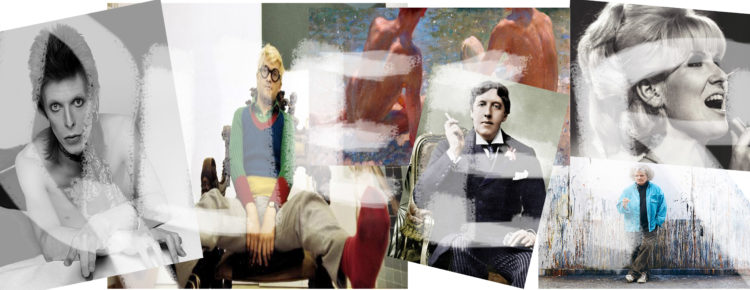Queer As Art
16th August 2017

…and There's Nowt So Queer As Folk…(ref: Welsh Bible Ch.1 vs.1)
In 1967 when the UK partially decriminalised #homosexuality I was 10 years old and my family were in the process of getting out of Kenya and moving to Dubai. And I was about to be shipped off to a boarding school in Surrey UK. Obviously I was oblivious to this monumental landmark in social justice and really only became aware of it this month while browsing through #BBC TV programmes. ( Ok, who mumbled "she doesn't get out much.."!) One after the other, a deluge of documentaries and dramas featured as part of the Gay Britannia season of #BBC programming to mark the 50th anniversary since being #gay was no longer a criminal offense. And much of it made for harrowing viewing.
 A FULL-LENGTH portrait of Oscar Wilde has gone on display for the first time in the UK – next to the cell door from the prison where he was once locked up.
A FULL-LENGTH portrait of Oscar Wilde has gone on display for the first time in the UK – next to the cell door from the prison where he was once locked up.
On the Tate Modern Queer British Art exhibition page, the first question posed is: Why is the word queer used for this exhibition? The curator Clare Barlow replies:
"More recently, of course, it has become reclaimed as a fluid term for people of different sexualities and gender identities. Historians of sexuality have also argued that it is preferable to other terms for sexualities in the past as these often don't map onto modern sexual identities."
Reclaimed is the word that jumps out at me. How best to deflate the sails of your derisive detractors than to claim and embrace the word that was intended to offend and wound. African Americans have done the same thing with the word nigger.

Interesting arrangement. Side by side, the overtly gay nude male and the long arm of the law.
Hettie Judah writes in her review:
"..the exhibition is haunted by a lingering shadow of tragedy. The exhibition’s date span coincides at the one end with the abolishment of the death penalty for sodomy and at the other, the partial decriminalization of sex between men. There is no shortage here of terrible stories of lives falling apart following arrest, prejudice, and prosecution—but anguish and torment are also established tropes in Romantic narratives of longing and heartache. These two faces of suffering—the one imposed and often life destroying, the other aestheticized and to a certain degree relished—are treated as indistinguishable, as if torment in and of itself was somehow the inevitable fruit of queer desire rather than simply of desire."
What I came to realise as I watched the #BBC documentary "Queer As Art" 
 The artworld owes much to the "Queer Saint" Peter Watson who bankrolled artworld giants.
The artworld owes much to the "Queer Saint" Peter Watson who bankrolled artworld giants.
"The figure that emerges is at once a gay playboy with a taste for rough trade and an aesthete in the purest sense of the word who left an indelible if largely unacknowledged mark on British art."
Why was the whole issue of homosexuality, and its decriminalisation, focused on male gays without so much as even a footnote mention of granting the same rights to lesbians?
Laura Knight, Self portrait and Nude (1913).
Photo courtesy National Portrait Gallery
Were lesbians regarded as not being such a threat, as gay males were, to the patriarchal establishment and the stabilisation of society built on the bedrock of the traditional heterosexual family? Was the perception of two women having it off less morally reprehensible than two guys, and if so, why? Were lesbians simply not so visible as gay males and therefore less of a threat?
Another documentary posing the question of whether its safe to be gay in the UK today suggests that decriminalisation doesn't mean squit with some Brits: gay bashing season is still open. Why do people feel the need to gay bash? And bashing is a candy coated word if ever I heard one: more like criminal murderous assault. What exactly is so threatening about a gay male? I mean, come on, they are the most limp wristed fay femmes walking the planet! (Ok just kidding, not all). They are divine, they're charming, they're stylish, and they're consummate conversationalists. Many of my best male friends are gay and for good reason. They're not interested in chatting me up (like heterosexual males with their "Married? No? You need a man! Lesbian? Oh then you just haven't met a REAL man!" During this exchange I'm obviously looking at one). Anyhow, that leaves a lot of room for interesting and usually very witty conversation, and gay men are so good at it. At the roots of this cranking up the campness I think is that "reclaiming" word again-a brazen celebration of the gay caricature drawn by homophobics. Wit is also a defensive mechanism, a way of dealing with and disarming both covert and overt bigotry. And its a sardonic acknowledgement that the drama of life as we know it is really a complete utter comedy.
Speaking of comedy, just take a look at social media: Facebook and Twitter etc. Aside from its very welcome informative content, these platforms of social dialogue are pariah swamps infested with rabid hordes of dysfunctional individuals. The braying for blood letting is almost palpable. And when people aren't ranting, they're begging for attention. Or posting cute puppy/kitty stories. Or worst of aIl, "Jesus Loves You! Type Amen and share (or be damned)". When I'm not bristling with sarcastic laughter, I find the whole thing a very disturbing indictment of the state of human society. So much for social media's mantra of bringing people together; judging from FB content it looks like people are drifting further apart.
What's this got to do with gay bashing? Maybe I've skidded off on a tangent but I'm sure if I worked hard at it I could find at least a tenuous link between marginalised elements of society being attracted to the anonymous shield that FB provides for ranting and spreading of bigotry in its multiple forms.
In the documentary on Queer As Art, Jeannette Winterson,internatoonally aclaimed author of "Oranges Are Not The Only Fruit" said something like 'human sympathy is the by-product of being different and having at some point in one's life found oneself standing on the outside (of mainstream society)". I can so relate to that.
I think that perhaps if more people experienced being marginalised, if only briefly, it might make for a more tolerant compassionate world.
Interesting queer art: Inspired by Mexican religious art, photographer Gabriel Garcia Roman portrays queer people of color as saints and warriors.




